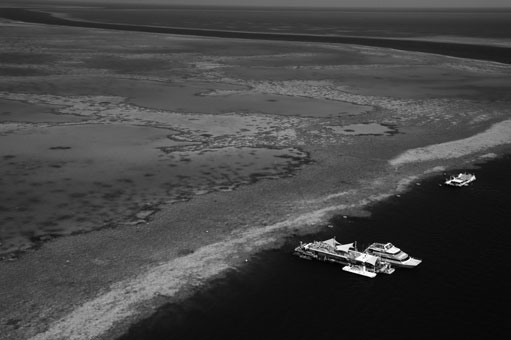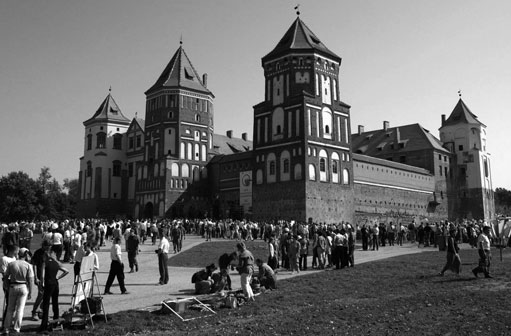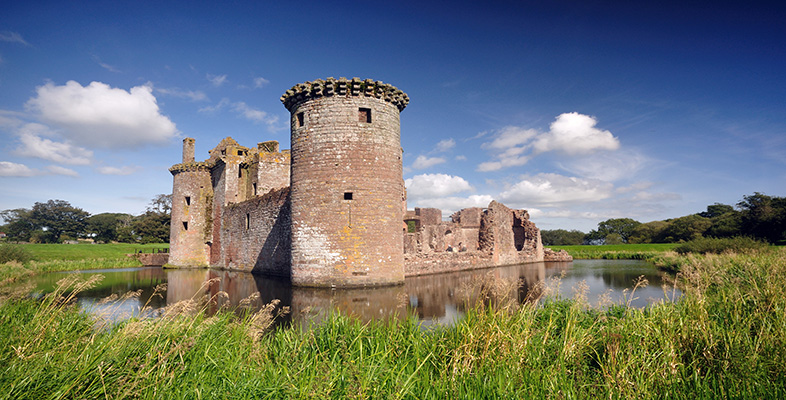2 Explaining heritage
This course begins with two photographs: a picture of the Great Barrier Reef in Australia (Figure 1) and a picture of the Mir Castle complex in Belarus (Figure 2).
The photographs appear to show very different types of place, in locations that are widely geographically spaced. One of these is a ‘natural’ place, the other is humanly made (a building, albeit a very grand one). In what ways might we characterise the similarities between the two places? What qualities can we find that link them?
Although they are very different, both of these places are considered to be ‘heritage’, indeed ‘World’ heritage, and both are listed on the United Nations Educational, Scientific and Cultural Organization (UNESCO) World Heritage List. This course concentrates on the ways in which these two very different entities, in two very different places, can both be understood as ‘heritage’.

The Great Barrier Reef is the world’s most extensive stretch of coral reef. The reef system, extending from just south of the Tropic of Capricorn to the coastal waters of Papua New Guinea, comprises some 3400 individual reefs, including 760 fringing reefs, which range in size from under 1 ha to over 10,000 ha and extend for more than 2000 km off the east coast of Australia. The Great Barrier Reef includes a range of marine environments and formations, including approximately 300 coral cays and 618 continental islands which were once part of the mainland. The reef is home to a number of rare and endangered animal and plant species and contains over 1500 species of fish, 400 species of coral, 4000 species of mollusc and 242 species of birds plus a large number of different sponges, anemones, marine worms and crustaceans and other marine invertebrates. The reef includes feeding grounds for dugongs, several species of whales and dolphins, and nesting grounds of green and loggerhead turtles (United Nations Environment Programme World Conservation Monitoring Centre, 2008).

The Mir Castle complex is situated on the bank of a small lake at the confluence of the river Miryanka and a small tributary in the Grodno Region of what is now known as the Republic of Belarus. The castle was built in the late fifteenth or early sixteenth century in a style that architects familiar with the form it took in central Europe would recognise as ‘Gothic’. It was subsequently extended and reconstructed, first in ‘Renaissance’ and then in ‘Baroque’ styles. The castle sustained severe damage during Napoleon’s invasion of Russia in 1812 and was abandoned as a ruin. It was subsequently restored at the end of the nineteenth century, at which time the surrounding parkland received extensive landscaping. Mir Castle is considered to be an exceptional example of a central European castle, reflecting in its design and layout successive cultural influences (Gothic, Renaissance and Baroque) as well as the political and cultural conflicts that characterise the history of the region (UNESCO, 2008).
What makes these places ‘heritage’? And what makes them part of the world’s heritage? The process of nominating a place for inclusion on the World Heritage List involves an assessment of the ways in which a place meets a particular set of criteria for inclusion. This argument is developed by a body representing the sovereign state of the territory in which the site exists and is submitted to a committee in charge of assessing the nominations. Although it would be possible to look in detail at the criteria for inclusion, and at the values implicit in the criteria, it is clear that these sites are defined as heritage by the sheer fact that they have been classified as such through inclusion on a heritage register. This process by which an object, place or practice receives formal recognition as heritage and is placed on a heritage register can be termed an ‘official’ heritage process. Once places become statutory entities and are recognised as belonging to heritage by their inclusion on an official heritage list, they are ‘created’ as ‘official heritage’ and subject to a series of assumptions about how they must be treated differently from other places. For example, official heritage places must be actively managed and conserved, and there is an expectation that funding must be allocated to them so that this can occur.
Although both of these places are recognised through their listing as belonging to the world’s heritage, they have a range of different meanings for the local people who interact with them on an everyday basis. For example, the Barrier Reef, which is understood to be World Heritage on the basis of its biodiversity and recreational values, is a source of sustenance, livelihood and spiritual inspiration for the many different groups of Indigenous Australians who live along the Queensland coastline. They would traditionally understand their relationship with the reef as one of custodianship and the right to control access, hunt, fish and gather in its environs. Clearly the reef’s promotion as a World Heritage site implies that it is ‘owned’ (at least culturally) not only by local people but also by the world community. So there is the potential for a range of different ways of relating to, understanding the significance of, and giving meaning to heritage objects, sites and practices. This range of values of heritage may not be well catered for within traditional western models of heritage and official definitions of heritage. In this case, such differences may give rise to conflict over who has the right to determine access and management of different parts of the reef. Indeed, in most cases the official and the local would be thought of as competing forms of heritage. Heritage itself is a dynamic process which involves competition over whose version of the past, and the associated moral and legal rights which flow from this version of the past, will find official representation in the present.
This brief example embodies the two inter-related understandings of heritage that form the central focus of this book: the largely ‘top-down’ approach to the classification and promotion of particular places by the state as an embodiment of regional, national or international values which creates ‘official’ heritage; and the ‘bottom-up’ relationship between people, objects, places and memories which forms the basis for the creation of unofficial forms of heritage (usually) at the local level. Critical heritage studies, in its most basic sense, involves the investigation of these two processes and the relationship between them. Heritage studies is an exciting new interdisciplinary field of inquiry which draws on a range of academic disciplines and skills including history, archaeology, anthropology, sociology, art history, biology, geography, textual analysis and visual discrimination, to name but a few. The aim of this book is to form an introduction to heritage as a global concept, and critical heritage studies as a field of inquiry.
